Cabs M-O
Cabochons Index by Name
A B C D E F G H I J K L M N O P Q R S T U-V W X-Y-Z
Malachite - Mohs 3.5-4

A dark green to light green stone that normally has wonderful banding patterns. The color comes from copper and you will often find malachite intergrown with other colorful copper ores such as chrysocolla, azurite, and cuprite.
A lot of the malachite I have purchased has come from Africa and a lot of the malachite combinations I have purchased come from the Southwestern US. It is found in many places around the world.
Malachite was popular for jewelry with the Egyptians, Greek, and Romans and remains popular today. It is a soft stone though and does require some TLC.
Marra Mamba
See Marra Mamba (often mispelled as mara mamba) under Tiger Eye.
Maw-Sit-Sit (Maw Sit Sit) (Mawsitsit) - Mohs 6.5-7
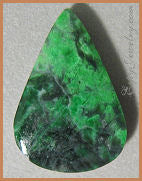
A chromium-rich metamorphic rock of brilliant emerald green interspersed with dark green-black blotches. Being a rock, it is composed of varying minerals. Kosmochlor (a mineral related to jadeite and formerly also called ureyite) is one of the primary components of both the brilliant emerald greens and the dark green-black patches. Other major components are a chromian-rich jadeite, chromite, and albite (a plagioclase feldspar).
Other minerals that may play in the cast - chromian eckermannite, chromian albite, symplectite (actually not a mineral but a microscopically-fine intergrowth of two or more minerals resulting from high-pressure metamorphism), chromite (small black grains of metallic luster), chlorite, natrolite, and serpentine.
Named after the place of origin, maw-sit-sit comes from Mawsitsit in Myanmar. Former names that are no longer used include jade albite, chloromelanite, chrome-jade, kosmochlor-jade, and chrome-albite.
Mica
Micas are an important group of minerals famous for cleaving in thin sheets. Although the sheets cleave off easily, the resulting flakes are fairly durable and create wonderful sparkles in rocks. There are more than 30 minerals in the mica group, including muscovite and lepidolite.
Mohs Hardness Scale
Developed by Friedrich Mohs, a number is used to indicate the relative hardness or softness of a mineral. It works on the principal that a hard mineral can scratch a softer mineral, but a soft mineral can not scratch a harder mineral. The relative scale accounts for differences in hardness simply by testing which mineral scratches another mineral. A soft mineral like fluorite can be scratched by all of the minerals above it on the scale. The higher up on the scale, the harder and more durable the gemstone is. The lower down on the scale, the softer the stone and the more TLC it requires.
2.5 - Fingernail
3.5 - Penny
5.5 - Pocket Knife
6.5 - Steel File
Moonstone (Adularia) - Mohs 6.0
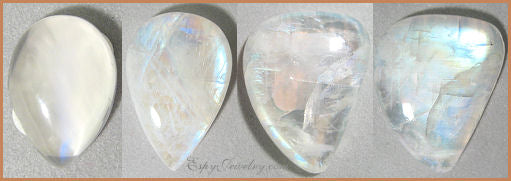
Moonstone is a feldspar. It is translucent to opaque with a bluish opalescence reminiscent of moonlight that glides over the surface of the cabochon as it is moved in your hand. Moonstone is normally found in white to cream to brown tones but it occurs in other colors as well.
Moonstone can be andularia, a potassium feldspar of the orthoclase species or it can be oligoclase, a plagioclase feldspar.
The color play in moonstone is called adularescence and is caused by refraction of light (interference phenomena) through the layered structure of the stone. The refracted ray has a different character and produces the moonlike glow.
The pictures above show each of the two stones photographed from two different angles. Below is a picture that caught a good look at the blue color the stone can show -
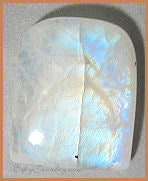
For pictures & more information, visit the International Colored Gemstone Assoc.
Moss Agate
Agate having random pattern of inclusions, often creating the appearance of seaweed or moss. Moss agate comes in many colors, but is often green.
Muscovite - Mohs 2 - 2.5
Muscovite is a mica. It can be colorless, white, silver, yellow, green, brown, and even red or violet. A green variety, tinted by chromium, is called fuchsite.
Opal - Mohs 5.5-6.5
Opal can be
precious - it has plays of color (the opal that Australia is famous for)
or
common - it does not have plays of color (fire opal, peruvian opal, etc)
Opal is made up of tiny, transparent silica spheres cemented together by a hardened silica gel with high water content. It is the arrangement of the spheres that determines if opal is precious or common. The two forms of opal can be found intermixed.
As water moves - runs down through the earth or bubbles up from hot springs - it can pick up silica and carry it into cracks, crevices, and cavities in rocks, including those caused by decomposing fossils. Over time, the water evaporates, silica spheres settle out, the remaining silica gels, and opal is created. Opal can be found in thin veins, sheets, nodules, or just "sparks" in a host rock. Opal is often found in areas with volcanic rocks and areas with hot springs.
Precious Opal is opal that displays "plays of color". In precious opal, the silica spheres occur in organized pockets, where the spheres are approximately the same size and have a very regular arrangement. The pockets diffract light and create colors - which color and how intense depends on the size and arrangement of the spheres. Diffraction changes with the viewing angle, so colors change and sparks flash out as the stone is moved. "Larger" spheres (a millionth of an inch) produce reds, which is considered a rarer color. Medium spheres produce blues and greens, which are more common colors. The smallest spheres create purples, which is considered a rarer color. All of the color plays are a result of optical diffraction.
In addition to the color plays, there is a background color. This is the color of the silica solution that is cementing all of the spheres together. It is defined in terms of color and also in terms of light transmission. ie: transparency, translucency, or opaqueness. While pure silica is transparent and colorless (crystal opals), fine impurities (iron, manganese, carbon, etc) in the silica solution give it colors from light colors (white opals) to dark colors (black opals). Gas bubbles and/or water content give the silica solution milkiness or cloudiness. Darker background colors add intensity to the color plays.
Precious opal is available as solid cabochons of precious opal, as doublets, and as triplets. It can be found in combination with potch as well as in combination with other host rocks, normally ironstone, where it is called boulder opal or matrix opal.
Solid cabochons are opal that is thick enough to stand by itself.
Doublets bond a dark backing like black potch to a thin layer of opal.
Triplets add a clear cap on top of a doublet.
Boulder opal is a cut as cabochons. Technically, I suppose some of it should be called boulder matrix opal. From my understanding, boulder opal is the correct name when opal is a sheet across the surface of the host rock, even if the host rock is poking through the surface of the opal in places. Boulder matrix opal or matrix opal is the correct name when the opal is intimately diffused in the cracks, crevices, and pores of the host rock. To me, it is not a really important difference, as I often see both in the same stone. I tend to refer to any of the stones that are a combination of the ironstone host, potch, and precious opal as boulder opal. In addition, there will often be a name in front of that, telling you where in Australia the boulder opal came from, such as Koroit Boulder Opal or Yowah Nut Boulder Opal. The price of boulder opals/matrix opals is dependent on how much precious opal is showing, the intensity of the precious opal colors, and how pleasing the overall patterns are - some are very scenic!
Precious opal, including boulder opal, comes predominately from Australia, but is also found elsewhere. Some notable sources:
Common Opal (Potch) is opal that does not have plays of color. Not all common opal is "common" though, including Fire Opal and Blue Peruvian Opal. In common opal, the spheres are irregular in size and there is no order to their arrangement or density in the rock. The spheres can also be absent, with the entire rock just composed of silica gel. Common opal can be transparent, translucent, or opaque. It can be colorless, white, blue, pink, red, orange, yellow, green, amber, grey, black . . . pretty much any color.
Some notable "common" opals -
Opal Fluorite
1) Fluorite impregnated and coated with opal.
2) A fine-grained intergrown mixture of (common) opal and fluorite, in which the degree of purple color is probably an indicator of the fluorite content.
3) See Tiffany Stone.
Opalite
Synonym for Opal. Also see Opal, Common. Also see Tiffany Stone.
Opalized
Replaced by or converted into opal.
Opalized Fluorite
1) Fluorite impregnated and coated with opal.
2) A fine-grained intergrown mixture of (common) opal and fluorite, in which the degree of purple color is probably an indicator of the fluorite content.
3) See Tiffany Stone.
Cabochons Index by Name
A B C D E F G H I J K L M N O P Q R S T U-V W X-Y-Z
A B C D E F G H I J K L M N O P Q R S T U-V W X-Y-Z
M
Malachite - Mohs 3.5-4

A dark green to light green stone that normally has wonderful banding patterns. The color comes from copper and you will often find malachite intergrown with other colorful copper ores such as chrysocolla, azurite, and cuprite.
A lot of the malachite I have purchased has come from Africa and a lot of the malachite combinations I have purchased come from the Southwestern US. It is found in many places around the world.
Malachite was popular for jewelry with the Egyptians, Greek, and Romans and remains popular today. It is a soft stone though and does require some TLC.
Marra Mamba
See Marra Mamba (often mispelled as mara mamba) under Tiger Eye.
Maw-Sit-Sit (Maw Sit Sit) (Mawsitsit) - Mohs 6.5-7

A chromium-rich metamorphic rock of brilliant emerald green interspersed with dark green-black blotches. Being a rock, it is composed of varying minerals. Kosmochlor (a mineral related to jadeite and formerly also called ureyite) is one of the primary components of both the brilliant emerald greens and the dark green-black patches. Other major components are a chromian-rich jadeite, chromite, and albite (a plagioclase feldspar).
Other minerals that may play in the cast - chromian eckermannite, chromian albite, symplectite (actually not a mineral but a microscopically-fine intergrowth of two or more minerals resulting from high-pressure metamorphism), chromite (small black grains of metallic luster), chlorite, natrolite, and serpentine.
Named after the place of origin, maw-sit-sit comes from Mawsitsit in Myanmar. Former names that are no longer used include jade albite, chloromelanite, chrome-jade, kosmochlor-jade, and chrome-albite.
Mica
Micas are an important group of minerals famous for cleaving in thin sheets. Although the sheets cleave off easily, the resulting flakes are fairly durable and create wonderful sparkles in rocks. There are more than 30 minerals in the mica group, including muscovite and lepidolite.
Mohs Hardness Scale
Developed by Friedrich Mohs, a number is used to indicate the relative hardness or softness of a mineral. It works on the principal that a hard mineral can scratch a softer mineral, but a soft mineral can not scratch a harder mineral. The relative scale accounts for differences in hardness simply by testing which mineral scratches another mineral. A soft mineral like fluorite can be scratched by all of the minerals above it on the scale. The higher up on the scale, the harder and more durable the gemstone is. The lower down on the scale, the softer the stone and the more TLC it requires.
- Talc
- Gypsum
- Calcite
- Fluorite
- Apatite
- Orthoclase Feldspar (Labradorite)
- Quartz (ex: amethyst)
- Topaz
- Corundum (ruby and sapphire)
- Diamond
2.5 - Fingernail
3.5 - Penny
5.5 - Pocket Knife
6.5 - Steel File
Moonstone (Adularia) - Mohs 6.0

Moonstone is a feldspar. It is translucent to opaque with a bluish opalescence reminiscent of moonlight that glides over the surface of the cabochon as it is moved in your hand. Moonstone is normally found in white to cream to brown tones but it occurs in other colors as well.
Moonstone can be andularia, a potassium feldspar of the orthoclase species or it can be oligoclase, a plagioclase feldspar.
The color play in moonstone is called adularescence and is caused by refraction of light (interference phenomena) through the layered structure of the stone. The refracted ray has a different character and produces the moonlike glow.
The pictures above show each of the two stones photographed from two different angles. Below is a picture that caught a good look at the blue color the stone can show -

For pictures & more information, visit the International Colored Gemstone Assoc.
Moss Agate
Agate having random pattern of inclusions, often creating the appearance of seaweed or moss. Moss agate comes in many colors, but is often green.
Muscovite - Mohs 2 - 2.5
Muscovite is a mica. It can be colorless, white, silver, yellow, green, brown, and even red or violet. A green variety, tinted by chromium, is called fuchsite.
N
O
Opal - Mohs 5.5-6.5
Opal can be
precious - it has plays of color (the opal that Australia is famous for)
or
common - it does not have plays of color (fire opal, peruvian opal, etc)
Opal is made up of tiny, transparent silica spheres cemented together by a hardened silica gel with high water content. It is the arrangement of the spheres that determines if opal is precious or common. The two forms of opal can be found intermixed.
As water moves - runs down through the earth or bubbles up from hot springs - it can pick up silica and carry it into cracks, crevices, and cavities in rocks, including those caused by decomposing fossils. Over time, the water evaporates, silica spheres settle out, the remaining silica gels, and opal is created. Opal can be found in thin veins, sheets, nodules, or just "sparks" in a host rock. Opal is often found in areas with volcanic rocks and areas with hot springs.
Precious Opal is opal that displays "plays of color". In precious opal, the silica spheres occur in organized pockets, where the spheres are approximately the same size and have a very regular arrangement. The pockets diffract light and create colors - which color and how intense depends on the size and arrangement of the spheres. Diffraction changes with the viewing angle, so colors change and sparks flash out as the stone is moved. "Larger" spheres (a millionth of an inch) produce reds, which is considered a rarer color. Medium spheres produce blues and greens, which are more common colors. The smallest spheres create purples, which is considered a rarer color. All of the color plays are a result of optical diffraction.
In addition to the color plays, there is a background color. This is the color of the silica solution that is cementing all of the spheres together. It is defined in terms of color and also in terms of light transmission. ie: transparency, translucency, or opaqueness. While pure silica is transparent and colorless (crystal opals), fine impurities (iron, manganese, carbon, etc) in the silica solution give it colors from light colors (white opals) to dark colors (black opals). Gas bubbles and/or water content give the silica solution milkiness or cloudiness. Darker background colors add intensity to the color plays.
Precious opal is available as solid cabochons of precious opal, as doublets, and as triplets. It can be found in combination with potch as well as in combination with other host rocks, normally ironstone, where it is called boulder opal or matrix opal.
Solid cabochons are opal that is thick enough to stand by itself.
Doublets bond a dark backing like black potch to a thin layer of opal.
Triplets add a clear cap on top of a doublet.
Boulder opal is a cut as cabochons. Technically, I suppose some of it should be called boulder matrix opal. From my understanding, boulder opal is the correct name when opal is a sheet across the surface of the host rock, even if the host rock is poking through the surface of the opal in places. Boulder matrix opal or matrix opal is the correct name when the opal is intimately diffused in the cracks, crevices, and pores of the host rock. To me, it is not a really important difference, as I often see both in the same stone. I tend to refer to any of the stones that are a combination of the ironstone host, potch, and precious opal as boulder opal. In addition, there will often be a name in front of that, telling you where in Australia the boulder opal came from, such as Koroit Boulder Opal or Yowah Nut Boulder Opal. The price of boulder opals/matrix opals is dependent on how much precious opal is showing, the intensity of the precious opal colors, and how pleasing the overall patterns are - some are very scenic!
Precious opal, including boulder opal, comes predominately from Australia, but is also found elsewhere. Some notable sources:
-
Ethiopia
Noted for a dark, liquid-looking opal that normally has part of the host rock of the nodule it was found in still attached. Although people often mistake my ammolite for opal when I am wearing it, this is the only opal I have seen that really has any resemblance to ammolite.
"Opalinda" has/had some great pictures of the area in Ethiopia where the opal is found, the nodules as found, and the nodules split open to show their delicious opal interiors. "Crysal Vine" has some interesting pictures of various nodules that have been split open, including an empty one, one that just has common opal filling the interior, and one with precious opal. There are also pictures of opals with the nodule ground away. The 2 sites will give you and understanding of why you normally see part of the matrix attached to these opals.
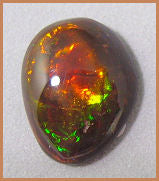
-
Lightning Ridge, New South Wales, Australia
Famous for black (dark) opal, one of the most sought after and valuable types of opal. This area also produces white (light) and crystal opals.
These are all solid black opals.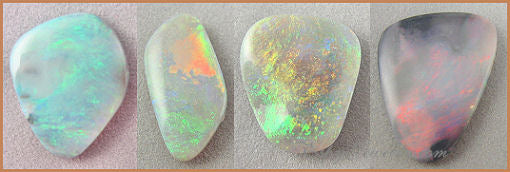
-
South Australia, including Andamooka and Coober Pedy.
-
Spencer Opal Mine, Idaho, US
If you are in Idaho, check their schedule to dig for your own!
The precious opal found in Spencer is usually too thin to be cut into solid cabochons. Most of it is made into triplets. To start, one side of the opal vein is ground perfectly flat until the host rock is gone and intense fire shows completely across the surface. Then a flat piece of black basinite or obsidian is epoxied to the ground layer, making a doublet. It is now turned over and ground on the opposite side, again until the host rock is gone and the opal shows its greatest intensity against the black background. At this time the opal is about the thickness of a hair. A domed, quartz/crystal cap is applied with epoxy and the opal triplet is ground to its final shape.
These are all triplets. The very thick caps really magnify the colors and make them pop.
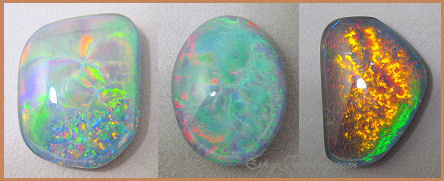
-
Queensland, Australia, including Koroit & Yowah
Famous for boulder opal, which is found sporadically and erratically in the desert of western Queensland. Koroit and Yowah are both opal mining areas in southwest Queensland.
Boulder opals and opal matrix result from silica solution seeping into cracks and crevices of ironstone (an iron rich type of sandstone) and then solidifying. The spaces in the ironstone that the opal fills could be relatively large & flat, resulting in large surface areas of opal, or the spaces could be very small and scattered, resulting in more pinpricks and flashes.
Yowah Nuts are small ironstone nodules about the size of walnuts. They are broken open to find opal deposits inside. They may have hollow centers or be filled with powdery clay or a pocket of opal. Opal may also be found in thin veins or sparkles interspersed in the ironstone concretion.
These stones are boulder opals, with a thin layer of opal sitting on top of the ironstone host it was found on. The colors in person are SOOO much livelier than the pictures!
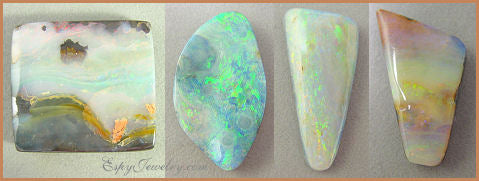
The first two stones below are boulder matrix opal, with the precious opal sparkling out from the ironstone host it was found in. The 3rd has host rock, common opal, and precious opal all mixed up together. The last is a boulder opal that I would say has no precious opal in it at all, till I hold it just right under the light and see the little green winks. But I like patterns of the common opal in it and made up into a pendant, it gave the impression of Japanese landscape paintings.
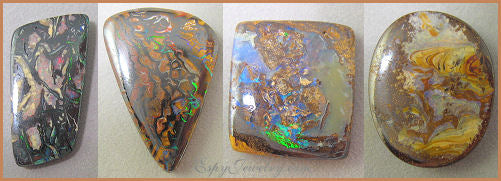
Common Opal (Potch) is opal that does not have plays of color. Not all common opal is "common" though, including Fire Opal and Blue Peruvian Opal. In common opal, the spheres are irregular in size and there is no order to their arrangement or density in the rock. The spheres can also be absent, with the entire rock just composed of silica gel. Common opal can be transparent, translucent, or opaque. It can be colorless, white, blue, pink, red, orange, yellow, green, amber, grey, black . . . pretty much any color.
Some notable "common" opals -
-
Bubble Opal - see Satin Flash Opal.
-
Fire Opal - Orange, to orange-red, to yellow. The best are transparent and suitable for faceting. Many are translucent to opaque. Mexico is the most famous place for fire opal, however they are also found elsewhere. They are also referred to as cherry opals.
-
Geyserite - Opalized silica sinter, often found around hot springs and geysers in glassy "cauliflowerlike" masses.
-
Hyalite - Colorless, transparent, glassy looking opal with a strong sheen. Also called glass opal, waterstone, water opal, and Muller’s glass, it occurs in volcanic environments where silica deposited at high temperatures. It’s structure is more similar to glass than to the spheres of typical opal. Hyalite glows green under a blacklight (ie, it fluoresces green).
-
Macedonia Green Opal - opaque green opal from Macedonia.

-
Napa Yellow Opal - opaque yellow opal from Napa, CA.
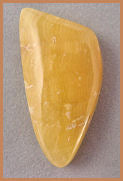
-
Peruvian Blue Opal - opaque to translucent blue to blue-green opal from Peru. My favorites are scenic pieces with dendrites or pleasing inclusions of the host rock.

-
Peruvian Pink Opal - opaque pink opal from Peru. My favorites include scenic black dendrites.
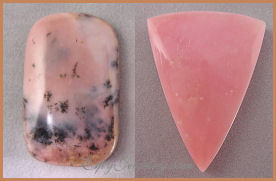
-
Satin Flash Opal - a bubbly opal from Milford, Utah (Beaver County, Utah). Also called bubble opal.
The colors in this opal range from whites and champagnes to peaches and browns. Light bounces off the internal bubble structure and makes it sparkly. On some stones, as you turn the stone around, you may lose the bubbles and see lines instead.
People selling it call it hyalite, but then their description describes geyserite. Whichever type of opal it actually is, material found in veins thick enough to cut as cabochons has only been found in this one small location, making it rare.

Opal Fluorite
1) Fluorite impregnated and coated with opal.
2) A fine-grained intergrown mixture of (common) opal and fluorite, in which the degree of purple color is probably an indicator of the fluorite content.
3) See Tiffany Stone.
Opalite
Synonym for Opal. Also see Opal, Common. Also see Tiffany Stone.
Opalized
Replaced by or converted into opal.
Opalized Fluorite
1) Fluorite impregnated and coated with opal.
2) A fine-grained intergrown mixture of (common) opal and fluorite, in which the degree of purple color is probably an indicator of the fluorite content.
3) See Tiffany Stone.
Cabochons Index by Name
A B C D E F G H I J K L M N O P Q R S T U-V W X-Y-Z
 Unique, One-of-a-Kind Settings for Unique, One-of-a-Kind Stones
Unique, One-of-a-Kind Settings for Unique, One-of-a-Kind Stones









